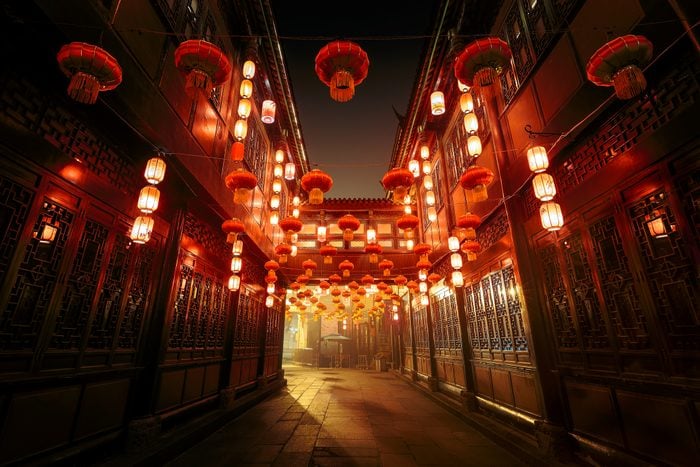Learn the legends, superstitions and clever wordplay behind these popular Lunar New Year traditions
12 Lunar New Year Traditions, Explained

Clean up to prepare for the new year
Each year is seen as a fresh, new beginning, so starting it off with a clean house is important. “It is believed that house cleaning should be done before the new year’s eve, which is described by a saying: Say bye to the old, and welcome the new,” says Sijia Yao, PhD, an assistant professor of Chinese language and culture at Soka University of America in Aliso Viejo, California.
Cleaning the house before the new year also means getting rid of anything negative, like dirt and clutter. “Leading up to the new year, you should clean as much as possible to clear out the bad luck and any leftover ill feelings from the previous year,” says Giannina Ong, the editor-in-chief of Mochi Magazine, the longest-running online publication for Asian American women. What happens if you don’t clean your home before the Lunar New Year? According to Yao, “it is believed that it may bring bad luck or prevent new opportunities from coming in.”
However, if you don’t manage to clean your home in time, don’t try to make up for it by cleaning on New Year’s Day. On that day, you’re not supposed to clean at all. This is because people believe that good luck accumulates quickly around at the start of Lunar New Year, thanks to the celebratory and harmonious environment, along with rituals and customs intended to attract fortune and prosperity. For this reason, “people do not sweep, wash or discard trash on the first two days of the new year because they do not want to get rid of the accumulated fortune and blessings,” Yao adds.
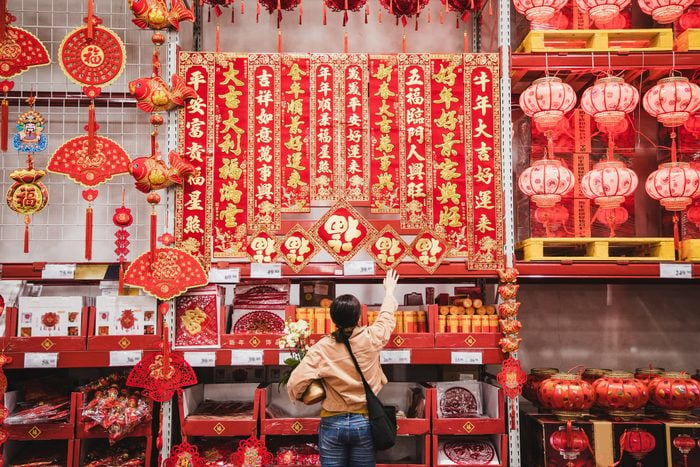
Decorate to invite good fortune
Decorating your home for Lunar New Year is centered around the idea of bringing luck to your household. “Red and gold are the colors of choice,” says Li-Rong (Lilly) Cheng, PhD, executive director of the Chinese Study Institute, managing director of the Confucius Institute, co-chair of the Asian Task Force and a professor in the college of health and human services at San Diego State University. The color red symbolizes new life and prosperity; gold, meanwhile, is associated with happiness, wealth and power.
People also adorn their walls with woodblock prints featuring traditional images associated with the new year, Yao says. “The content of new year pictures ranges from a mother holding a healthy baby boy, auspicious symbols, to gods and idealized scenes of domestic life.” You may also find red paper cutouts glued to windows of Chinese homes to bring good wishes; two fish swimming among lotus blossoms signifies prosperity, while a magpie on a tree calls for happiness.
Finally, there are spring couplets—Chinese idioms of good fortune that convey blessings and wishes for prosperity, happiness and good fortune, Yao says. They may say things like: “With each passing year, we gain longevity; Spring fills the universe, and happiness fills our home” or “The spring breeze brings warmth, flowers emit fragrance everywhere; Good fortune comes to our door and brings good luck.” The spring couplets are chosen carefully to match the sentiments of the household for the coming year, and they’re written in calligraphy on red paper and displayed prominently on doorways or hung on gates to invite good luck right into the home.
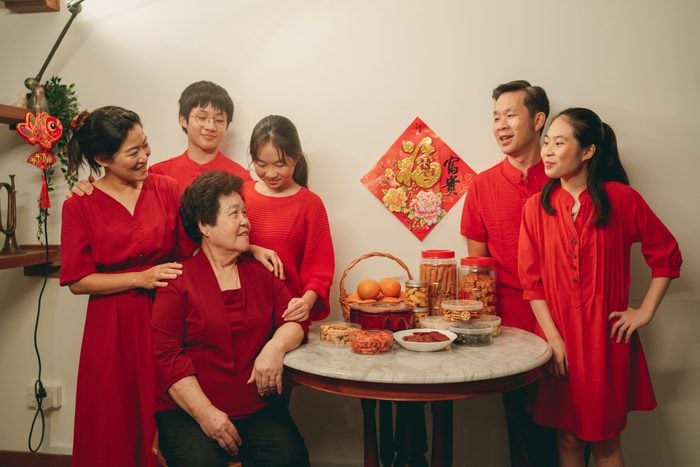
Visit family
Similar to Thanksgiving and Christmas, “Chinese New Year is a holiday for people to get together with family members, to celebrate the spring and the start of the new year,” Leung says. More specifically, the Lunar New Year tradition involves visiting family and friends starting on the morning of the first day of the new year around 8 a.m. or 9 a.m. “This practice symbolizes bringing good fortune to relatives and friends as early as possible in the new year,” Yao says.
When the living members of a family gather together for Lunar New Year, they make offerings to ancestors in order to pay respects to and show remembrance of those from previous generations. “Common offerings include incense, food (like fruits, meat, rice and sweets), and paper money burnt as a symbolic offering,” Yao explains. “The offerings are placed on a home altar or at a family grave, accompanied by prayers and sometimes rituals.”
In China, the Lunar New Year comes with a one-week vacation. People across the country flock to their families in what is often called “the world’s largest human migration.”
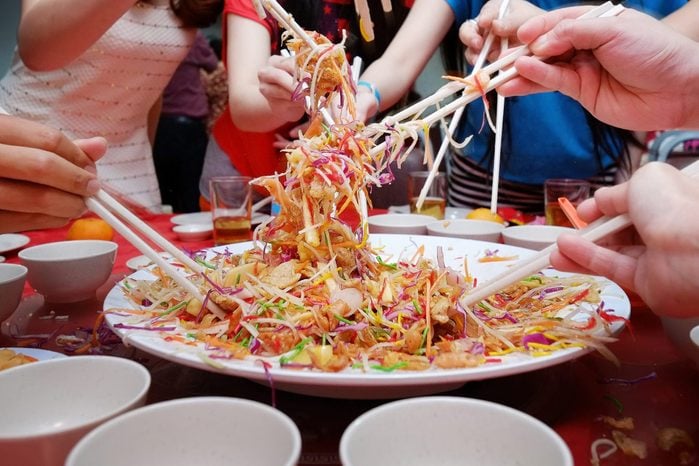
Eat auspicious food
Like most holidays, there are special, symbolic foods eaten during Lunar New Year, though the specifics sometimes vary depending on the region. For example, “northern Chinese [people] eat dumplings and hide a coin in some of the dumplings,” Cheng says. “The ones who get those dumplings will have a very lucky year.”
People in southern China prepare rice cakes, which mean “climbing higher in the new year,” Leung explains. These sweet rice cakes, Yao adds, are “not only luxuriously delicious but also heavily symbolic of blessings and good luck.”
So-called “longevity noodles” are also a common feature of new year meals. “On both birthdays and Lunar New Year, we make sure to eat long noodles,” Ong explains. “You can’t break them while cooking or cut them while eating either, because the length of the noodles is a symbol of longevity.” In addition to these long-life noodles, egg rolls (shaped like gold bars) are eaten for wealth and prosperity.
Beyond that, a number of other traditional Chinese New Year dishes feature foods that are eaten because of how their names sound. For example, yú, the Mandarin word for “fish,” sounds like the word for “surplus.” Fish, a traditional Lunar New Year food, is most often prepared steamed and whole. It’s typically the last dish to be served during a meal—a symbol of wishes of abundance from the host. Similarly, hosi, the Cantonese word for “oyster,” sounds like a phrase meaning “fortunate situation,” so the shellfish are also eaten for the Lunar New Year.
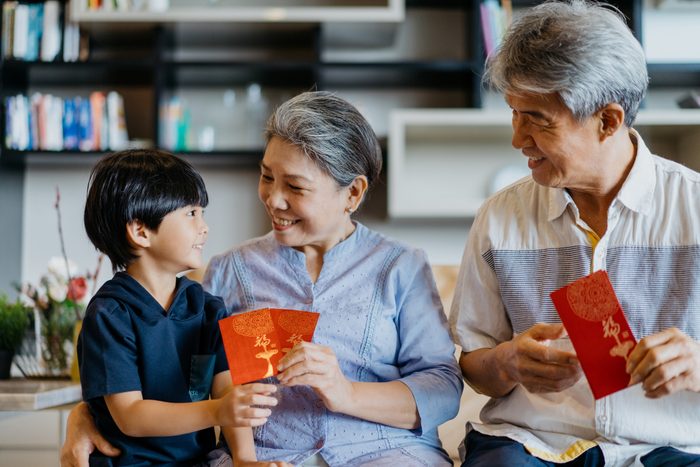
Hand out red envelopes
Out of all the Chinese New Year customs and traditions, this one might be a young person’s favorite. Every new year, adults give children red envelopes containing paper money and/or coins. “The red envelope is called yasuiqian, a term that is derived from its homophonous word, which means ‘money that suppresses bad spirits,'” Yao explains. “The amount of the money varies based on the giver’s financial status, closeness of the relationship and regional customs.” The amount can range from small sums like 10 or 20 Chinese yuan ($1.40 to $2.80 USD) for acquaintances or distant relatives, to hundreds or even thousands of Chinese yuan ($15 to hundreds of dollars) for immediate family members.
While the amount varies, there are some underlying rules to follow. “Traditionally, the amount in red envelopes should be in an even number, as even numbers are considered lucky in Chinese culture,” Yao says. “However, the number four is avoided because it is a homophone for ‘death.’ Common practice is to give money in amounts like 200, 600 or 800 Chinese yuan ($28, $82 or $112).”
What’s the root of this Lunar New Year tradition? According to legend, giving children eight coins in a red envelope protected them from a demon named Sui who visited on the eve of Chinese New Year, but this story isn’t widely shared anymore.
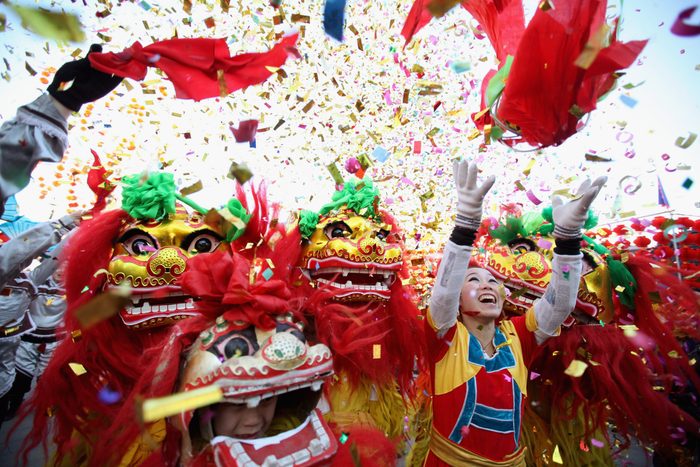
Watch dragon and lion dances
If you go to a Chinese New Year festival, chances are you’ll see a lion or dragon dance. “In traditional Chinese culture, lions are symbols of luck and happiness, and dragons [symbolize] braveness and power,” Leung explains. Both of these traditions are used to chase away evil spirits, scare away a monster named Nian and bring good luck. Accompanied by percussion instruments, the noise and ferocity of the animals protect all in their presence.
“The active dance of aggressive lions and powerful dragons, along with loud music, will kick out devils and demons,” Yao says. “The dragon and lion players work together to present a wonderful performance that is combined with skillful dancing and smooth martial-arts moves.”
Lion dances are most often performed by two dancers per colorful lion costume: one to hold the lion’s head and another to crouch at the lion’s tail. They are high-energy and entertaining, often showcasing kung fu and humor. Chinese dragon dances include an odd number of people holding the dragon costume up by poles and undulating its long body in impressive synchronicity.
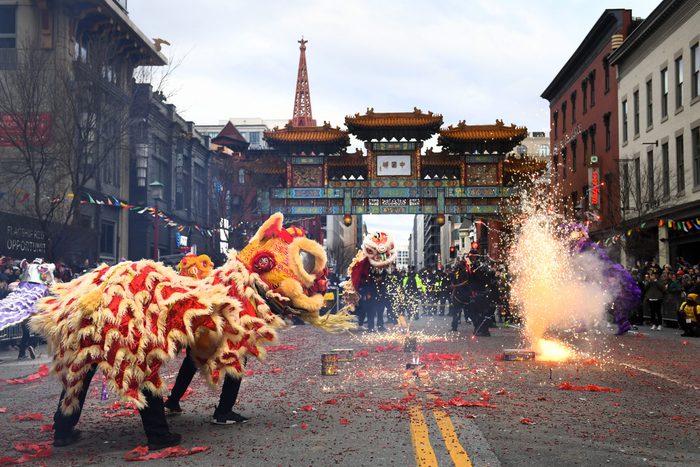
Make some noise
Going back to the legend of Nian, noisy activities are encouraged on Chinese New Year to scare away evil spirits. Little red firecrackers are the most popular means of this noise, and if you walk the streets of Chinatown on Chinese New Year’s Eve or Day, you’ll likely hear the pop and smell the gunpowder. “In the present day, people use fireworks to create a festive atmosphere and wish for good luck in the new year,” Leung says. According to Lunar New Year tradition, the person who lights the first firework of the new year will be showered with good luck.
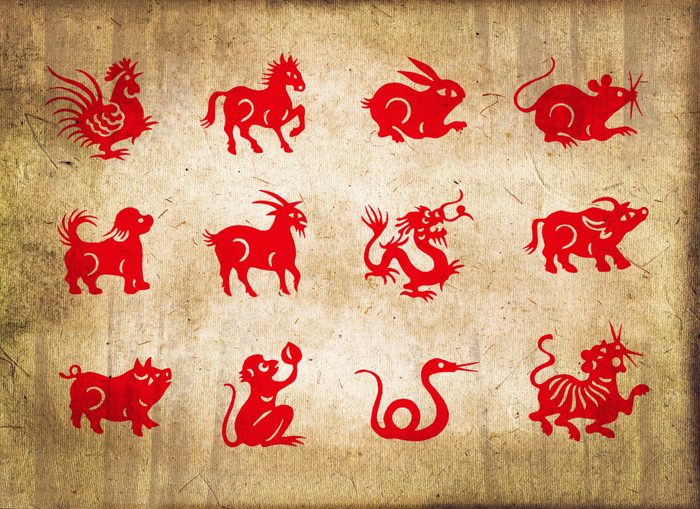
Protect yourself in your zodiac year
Each Chinese year matches with one particular Chinese zodiac sign, represented by an animal. According to Leung, you’ll want to take some precautions during “your” year because there’s a superstition that a person’s zodiac birth year will be a tumultuous time. As noted earlier, 2024 is the Year of the Wood Dragon, and 2025 will be the Year of the Wood Snake, so plan accordingly!
Fortunately, there is a way to nudge all that action away from bad luck and into positivity. “People wear red—red underwear and socks, as well as red bracelets—to avoid bad luck,” Leung says. Accessories made from jade, which is believed to have protective powers, are also popular during one’s zodiac year.

Dress for success
Not sure what to wear for the Lunar New Year celebrations? Opt for a new outfit—ideally, a red one. “The color red is Chinese people’s favorite for weddings, festivals and even daily use because it is believed to be a lucky color that can scare away evil spirits and bring good luck,” Yao explains. “A new outfit means a brand-new start in the beginning of the new year: promising and hopeful.”
If you don’t have anything red, other bright colors like pink and yellow are also acceptable, but stay away from white, black and any other dark colors. In the Western world, black is associated with funerals, but in Vietnam and China, people wear white to funerals.

Celebrate the Lantern Festival
The Lantern Festival falls on the 15th day of the new year and marks the end of the Lunar New Year celebration. “This is the first time the moon becomes full in the new year,” Yao says. “In the evening, people enjoy glutinous rice balls, whose shape is like the full moon and represents reunion and happiness. It is celebrated to promote reconciliation, peace and forgiveness.”
During this festival of good fortune, which likely dates back nearly 2,000 years to the ancient Eastern Han Dynasty, people light traditional paper lanterns to symbolize letting go of the past and welcoming a bright future. Riddles are also sometimes are attached to the paper lanterns. “Whoever guesses the answer to the riddle will get a lovely award,” Yao says. “Traditionally, local organizers of the Lantern Festival or community leaders would give out awards for solving riddles. The awards are typically small gifts or tokens, [which are] not placed inside the lanterns.”

Visit a new year market
Prior to the Lunar New Year, special markets in China, as well as local Chinatowns in the United States and other countries with large Chinese populations, sell the supplies needed to prepare the traditional new year dinner, including rice cakes, oranges, dried oysters and turnips. But that’s not all you can find there: “In the open-air markets, abundant commodities related to the Lunar New Year are displayed for purchase, such as food, clothes, red couplets, fireworks and auspicious plants,” Yao says. For example, San Francisco’s Chinatown has an annual flower market fair, while Oakland’s Lunar New Year Bazaar features Chinese, Korean and Vietnamese art, food and beverages.

Follow the rules
While many of the rules are similar across the cultures in which this holiday is celebrated, they do vary from region to region. In addition to the Lunar New Year traditions discussed above, there are a number of taboos, which, if broken, are thought to bring bad luck in the new year, Yao explains.
- Don’t break anything fragile. Think: glasses, plates or cups. “It is believed to break good luck if these fragile things are broken,” Yao says.
- Don’t wash or cut your hair. “Like sweeping and trash-dumping, washing or cutting hair is seen as kicking your good fortune away in the new year,” Yao explains. “People typically avoid cutting their hair for at least the first month of the Lunar New Year, as cutting hair during this period is considered to bring bad luck, especially to maternal uncles.” Generally speaking, you should wait until the second lunar month (a few weeks after the new year begins) to cut your hair.
- Be positive. Avoid crying, mourning and “speaking unfortunate words as death, illness or loss to avoid living in any negative way next year,” Yao says.
About the experts
|
Why trust us
Reader’s Digest provides an easy-to-understand guide to all things astrology—from understanding sun signs, moon signs and rising signs to exploring each zodiac sign’s strengths, challenges and desires. You’ll learn about your ideal match in love, career, hobbies and more, as well as learn how big astrological events will affect you. We’re committed to producing high-quality content by writers with expertise and experience in their field in consultation with relevant, qualified experts. We rely on reputable primary sources, including practicing astrologers, as well as our writers’ personal experience where appropriate. For this piece on Lunar New Year traditions, Tria Wen tapped her longtime experience as a journalist who often covers Asian American culture and issues. We verify all facts and data, back them with credible sourcing and revisit them over time to ensure they remain accurate and up to date. Read more about our team, our contributors and our editorial policies.
Sources:
- Li-Rong (Lilly) Cheng, PhD, an expert in Chinese culture, history and language, and the author of Famous Chinese Folktale: Zodiac; email interview, July 5, 2024
- Jenny Leung, executive director of the Chinese Culture Center of San Francisco; email interview, 2021
- Giannina Ong, editor-in-chief of Mochi Magazine; email interview, 2021
- Sijia Yao, PhD, an assistant professor of Chinese language and culture, the coordinator of the Chinese Studies Program at Soka University of America and the author of Cosmopolitan Love: Utopian Vision in D. H. Lawrence and Eileen Chang; email interviews, July 10 and Sept. 10, 2024
- CNN: “Is it Chinese New Year or Lunar New Year? Depends who you ask”
- Smithsonian National Museum of Asian Art: “Lunar New Year Celebration”
- Wake Forest University Timothy S. Y. Lam Museum of Anthropology: “Chinese New Year Traditions”
- UNESCO: “Chinese Lantern Festival: An Illustration of Intercultural Exchange”
- Environment and Planning A: Economy and Space: “Visualizing the largest annual human migration during the Spring Festival travel season in China”
- University of California San Diego: “The Story of Demon Suì”





















